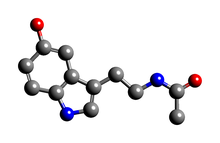N-Acetylserotonin

| |

| |
| Names | |
|---|---|
| Preferred IUPAC name
N-[2-(5-Hydroxy-1H-indol-3-yl)ethyl]acetamide | |
| Other names
N-Acetyl-5-hydroxytryptamine
N-Acetyl-5-HT | |
| Identifiers | |
3D model (
JSmol ) |
|
| ChEBI | |
| ChEMBL | |
| ChemSpider | |
| DrugBank | |
ECHA InfoCard
|
100.013.560 |
IUPHAR/BPS |
|
| MeSH | N-Acetylserotonin N-Acetylserotonin |
PubChem CID
|
|
| UNII | |
CompTox Dashboard (EPA)
|
|
| |
| |
| Properties | |
| C12H14N2O2 | |
| Molar mass | 218.256 g·mol−1 |
| Density | 1.268 g/mL |
Except where otherwise noted, data are given for materials in their standard state (at 25 °C [77 °F], 100 kPa).
| |
N-Acetylserotonin (NAS), also known as normelatonin, is a
Biological function
Like melatonin, NAS is an
TrkB receptor
NAS has been shown to act as a
Antioxidant properties
NAS acts as a potent antioxidant, NAS effectiveness as an anti-oxidant has been found to be different depending on the experimental model used, it has been described as being between 5 and 20 times more effect than melatonin at protecting against oxidant damage.[10] NAS has been shown to protect against lipid peroxidation in microsomes and mitochondria.[11] NAS has also been reported to lower resting levels of ROS in peripheral blood lymphocytes and to exhibit anti-oxidant effects against t-butylated hydroperoxide- and diamide-induced ROS.[12] NAS has also been observed to inhibit nitric oxide synthase.[13]
Anti-inflammatory effects
NAS has been reported to have
Miscellaneous
NAS may play a role in the antidepressant effects of
Through a currently unidentified mechanism, NAS may be the cause of the
Biochemistry
NAS is produced from serotonin by the enzyme aralkylamine N-acetyltransferase (AANAT) and is converted to melatonin by acetylserotonin O-methyltransferase (ASMT).
NAS is able to penetrate the blood–brain barrier, unlike serotonin.[17]
